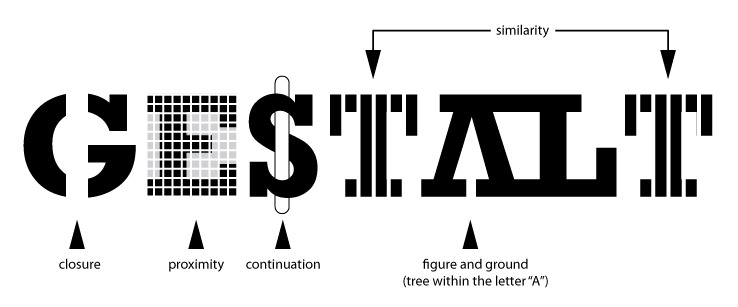
Gestalt Theory
Gestalt in German means “whole self” and was developed to be an existential, phenomenological, and process-based therapy. The initial goal is for clients to gain awareness of what they are experiencing in the “here and now.” The awareness process includes self-acceptance, interpersonal relationships, knowledge of the ever-changing environment, and responsibility for choices. Gestalt therapy promotes direct experience, rather than the abstractness of talking about situations. Rather than talk about a childhood trauma, the client is encouraged to become the hurt child. This incorporates directly experiencing events, rather than discussing abstract situations. Clients who were abused as children are encouraged to become the hurt child, instead of just talking about how they were hurt. Gestalt therapy incorporates a person-centered approach by having the client do their own seeing, feeling, sensing, and interpreting. A person exists by differentiating self from the environment and by connecting self to the environment. The boundary between self and environment must be firm enough to enable autonomous action, yet permeable to allow for exchanges. Mental and emotional disturbance arise when the boundary becomes blurred, lost, or rigid.
Contemporary Gestalt Therapy is known as relational Gestalt Therapy, which employs a therapy style that is supportive, accepting, empathic, respectful, dialogical, and challenging. An empathic and trusting relationship between the client and the therapist is most important under this model (Corey, 2009, p. 212). The clinician follows and trusts the client’s innate abilities to self-regulate through increased awareness and cathartic experiencing. Special attention is paid to the nonverbal communication of the client. By observing the client’s non-verbal communication, the therapist can help the client further awareness of themselves. This also helps to reinforce sensory awareness in the present moment. The therapist must also pay close attention to language in the form of client metaphors, “it” and “you” talk, questions that hide the client, and talk that denies power or uncovers a story.
Gestalt therapy postulates change can only occur by becoming who we are. If we try to become something we are not, we will remain the same; this is referred to as the paradoxical theory of change. This is similar to Rogerian psychology in that one must aim for congruency in their organismic values of the self. The therapist focuses on framing an environment that encourages client growth, rather than directing change. Toman and Woldt (2005) explain:
In psychotherapy, the therapist has the opportunity to meet the patient by identifying and respecting the validity of the patient’s experience while simultaneously manifesting his or her own experience. From this interaction, both the patient and the therapist can change and grow. Out of these interaction opportunities to try something new, to experiment, further opportunities come up and present for phenomenological exploration, experimentation in contact, refinement of understanding through experimentation, and exploration of new possibilities. (p. 99)
The therapeutic environment supports the client’s development of awareness and believes in their ability to self-regulate. Internal and external contact with the environment is monitored through interpersonal interaction and “reowning” parts of oneself that have been abandoned.
Gestalt asserts humans are inherently self-regulating and growth-oriented, and their symptoms cannot be understood apart from their environment. This principle is referred to as holism. Field theory is a way of understanding how a person’s context influences their experiences. A person must be observed in the context of their environment, which is relational and ever-changing. The figure formation process principle describes how the individual organizes experiences in their primary field into a figure and ground. The figure is the foreground experiences, and the ground is the background experiences. The therapy process moves background figures into awareness to become foreground figures. Anything a person does not work out from past experiences is acted out in present relationships. Problematic behaviors are brought into awareness with the guidance of the therapist, so the background experiences contributing to this behavior can be examined. The self-examination of behavior is supported by the self-regulation principle in that people can change behavior to restore emotional equilibrium and relational balance.
Phenomenological inquiry focuses on the what and how of the present moment, without asking why. Preoccupation with past or future is considered avoidant. A person’s awareness is not explained by unconscious motivation in Gestalt therapy. Instead, present awareness is viewed as valid and evolving. Feelings about the past are unexpressed and cause symptomatic behavior; they are referred to as unfinished business. This happens when a background experience is being pushed into the foreground and causes the individual to reach an impasse or a stuck point. These feelings are associated with distinct memories and fantasies. Symptoms of being stuck could be feelings of resentment, rage, hatred, pain, anxiety, grief, guilt, and abandonment. Therapists must pay attention to bodily sensations and assist clients in experiencing their stuck-ness, while working it through to acceptance. Gestalt therapy works with blocked energy, seeking a release and restoration. Special attention is given to where the energy is located, how it is used, and how it can be blocked. Client and therapist want to be aware of the resistance being expressed in their body, so mindful awareness is important. Through creative involvement in the Gestalt process, Zinker (1977) articulates that clients:
will move towards increased awareness of themselves, gradually assume ownership of their experience, develop skills and acquire values that will allow them, to satisfy their needs without violating the rights of others, become more aware of all of their senses, learn to accept responsibility for what they do, including accepting the consequences of their actions, move from outside support toward increasing internal support, be able to ask for and get help from others and to give to others.
These are the overall goals of the intervention, which can be accomplished using several available Gestalt techniques.
One exercise that works with the client’s internal dialogue is the empty-chair technique. The exercise has the client speak to an empty chair as if it were another person or another part of the client. This helps the patient get in touch with other aspects of the self. This exercise is an example of how Gestalt utilizes therapeutic transference. Furthermore, Nielsen (1980) articulates “empty-chair dialogues are a major method of working with
The experiential nature of Gestalt therapy provides many ways to apply its methods to diverse groups; however, timing and selection are critical. Gestalt therapy methods help integrate polarities within the patient by reconciling the diverse aspects of the two cultures in which they live. The client’s cultural framework must be carefully considered to adopt methods that are well-received. Some cultures see psychotherapy as unnecessary or view mental health patients as weak. Therefore, it would be inappropriate for the counselor to ask the patient to bring a family member or friend. When the client is from a cultural background that is more emotionally reserved, the practitioner may have to modify exercises to fit the emotionality of the individual.
Gestalt therapy has proven to be an effective evidence-based treatment for a variety of psychological disorders. Outcome studies have demonstrated Gestalt therapy to be equal to or greater than other therapies for various disorders. More recent studies have shown Gestalt therapy has a beneficial impact on personality disturbances, psychosomatic problems, and substance addictions. The effects of Gestalt therapy are stable in follow-up studies one to three years after the termination of treatment (Corey, 2009, p. 237).
Emotion-Focused Therapy (EFT) is closely related to Gestalt therapy. Many EFT interventions have been taken directly from Gestalt. Counselors could use EFT if they want to practice an evidence-l
EFT borrows heavily from gestalt therapy principles and methods… EFT is described as process-oriented, integrating humanistic, experiential and systems approaches. The therapist is seen as a process consultant and collaborator, and clients are viewed as nonpathological, responding rigidly for psychological survival. The therapy seeks to teach flexibility, with identification of disowned emotions and aspects of the self. Not only does this read—at times word for word–like a description of gestalt therapy, but reading transcripts and watching EFT therapists, one also recognizes gestalt therapy’s here and now oriented, phenomenological and experimental methodology (p. 31).
EFT blends the relational aspects of the person-centered approach and existential therapy. Clients learn flexibility and gain awareness of disowned aspects of the self. As you can see, EFT includes many techniques from Gestalt therapy, which makes it a good alternative. Additionally, Emotion-Focused Therapy is empirically supported and effective for many disorders.
Efficacy of EFT looks promising for treating adults and couples subject to childhood abuse or trauma. Individuals who have experienced this type of complex trauma view closeness as a threat, because they were violated by their caretakers as children. This fear of closeness makes it difficult for them to establish and maintain adult relationships. A study by Dalton, Greenman, Classen, and Johnson (2013) tested the efficacy of EFT for couples in which the female partner had a history of intrafamilial childhood abuse. They conducted a randomized controlled trial that included 24 couples from the city of Toronto in Ontario, Canada with a mean relationship length of 14 years. The sample was split into a control group and a treatment group. Both cohorts took the Dyadic Adjustment Scale (DAS) during the study to measure marital adjustment and satisfaction. The treatment group went through 24 sessions of EFT over 24 weeks. Mean DAS scores at pretreatment were 89.05 for the control group and 95.95 for the treatment group. After 24 weeks of therapy, posttreatment mean DAS scores were 88.32 for the control group and 104.81 for the treatment group. Posttreatment results were considered clinically significant, since the mean DAS score improved by over 10 points over baseline. Dalton et al. (2013) concluded, “First and most importantly, these results suggest that EFT can be an effective treatment for one of the most prevalent and troublesome consequences of childhood abuse: distressed couple relationships in adulthood” (p. 217). The results of this study are encouraging for using EFT to treat populations who have experienced trauma and abuse. Besides treating trauma and abuse, EFT has also proven to be an effective treatment for depression, anxiety, eating disorders, and borderline personality disorder.
Limitations
The older Fritz Perls style of Gestalt therapy is often subject to criticism, which encourages confrontation and de-emphasizes the cognitive factors of personality. Modern approaches give more attention to theoretical exposition and instruction. For a therapist to be effective with the Gestalt method, they must maintain a high level of personal development. Counselors need to have a strong clinical background pertaining to Gestalt theory and practice. Since some Gestalt techniques involve role playing, transference and countertransference can occur, so establishing appropriate boundaries between the therapist and patient is important. Client empathy and contextually timed experiments are required in every session. If a therapist uses the Fritz Perls techniques, they must be careful not to abuse power. Inexperienced therapists risk abandoning clients after they have had a dramatic catharsis, which could be detrimental and even unethical. To avoid additional damage, therapists need to work through the client’s emotional distress until closure. Counselors must know how to blend phenomenological and dialogic approaches.
References:
Brown, B. (2010). The gifts of imperfection: let go of who you think you’re supposed to be and embrace who you are. Center City, MN: Hazelden
Brownell, P. (2008). Handbook for Theory, Research, and Practice in Gestalt Therapy. Newcastle: Cambridge Scholars Publishing.
Corey, G. (2009). Theory and practice of counseling and psychotherapy, (9th edition). Pacific Grove, CA: Thompson Brooks/Cole.
Dalton, E. J., Greenman, P. S., Classen, C. C., & Johnson, S. M. (2013). Nurturing connections in the aftermath of childhood trauma: A randomized controlled trial of emotionally focused couple therapy for female survivors of childhood abuse. Couple And Family Psychology: Research And Practice, 2(3), 209-221. doi:10.1037/a0032772
Nielsen, A. C. (1980). Gestalt and psychoanalytic therapies: Structural analysis and rapprochement. American Journal of Psychotherapy, 34(4), 534-544.
Toman, S. M., & Woldt, A. L. (2005). Gestalt Therapy: History, Theory, and Practice. Thousand Oaks: SAGE Publications, Inc.
Zinker, J. (1977). Creative process in Gestalt therapy. New York: Brunner/Mazel.









